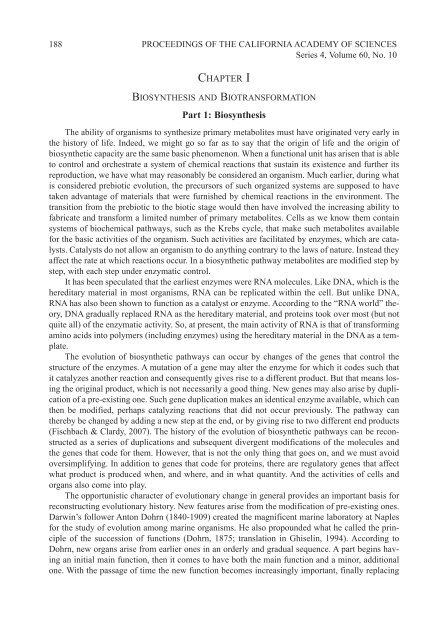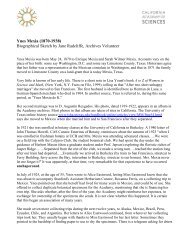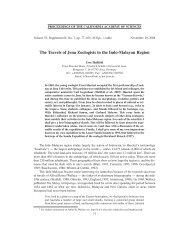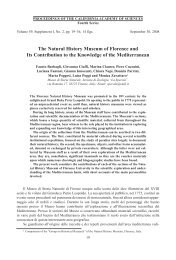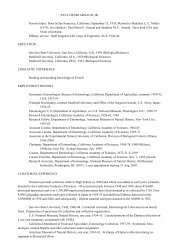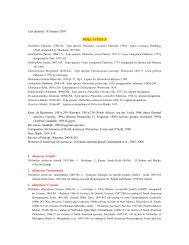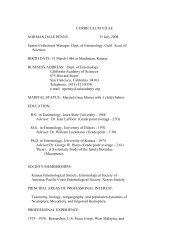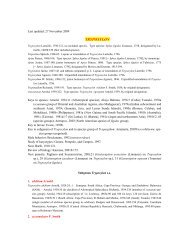Cimino&Ghiselin-tmpZXYZ:Template Proceedings_1.qxd.qxd
Cimino&Ghiselin-tmpZXYZ:Template Proceedings_1.qxd.qxd
Cimino&Ghiselin-tmpZXYZ:Template Proceedings_1.qxd.qxd
Create successful ePaper yourself
Turn your PDF publications into a flip-book with our unique Google optimized e-Paper software.
188 PROCEEDINGS OF THE CALIFORNIA ACADEMY OF SCIENCES<br />
Series 4, Volume 60, No. 10<br />
CHAPTER I<br />
BIOSYNTHESIS AND BIOTRANSFORMATION<br />
Part 1: Biosynthesis<br />
The ability of organisms to synthesize primary metabolites must have originated very early in<br />
the history of life. Indeed, we might go so far as to say that the origin of life and the origin of<br />
biosynthetic capacity are the same basic phenomenon. When a functional unit has arisen that is able<br />
to control and orchestrate a system of chemical reactions that sustain its existence and further its<br />
reproduction, we have what may reasonably be considered an organism. Much earlier, during what<br />
is considered prebiotic evolution, the precursors of such organized systems are supposed to have<br />
taken advantage of materials that were furnished by chemical reactions in the environment. The<br />
transition from the prebiotic to the biotic stage would then have involved the increasing ability to<br />
fabricate and transform a limited number of primary metabolites. Cells as we know them contain<br />
systems of biochemical pathways, such as the Krebs cycle, that make such metabolites available<br />
for the basic activities of the organism. Such activities are facilitated by enzymes, which are catalysts.<br />
Catalysts do not allow an organism to do anything contrary to the laws of nature. Instead they<br />
affect the rate at which reactions occur. In a biosynthetic pathway metabolites are modified step by<br />
step, with each step under enzymatic control.<br />
It has been speculated that the earliest enzymes were RNA molecules. Like DNA, which is the<br />
hereditary material in most organisms, RNA can be replicated within the cell. But unlike DNA,<br />
RNA has also been shown to function as a catalyst or enzyme. According to the “RNA world” theory,<br />
DNA gradually replaced RNA as the hereditary material, and proteins took over most (but not<br />
quite all) of the enzymatic activity. So, at present, the main activity of RNA is that of transforming<br />
amino acids into polymers (including enzymes) using the hereditary material in the DNA as a template.<br />
The evolution of biosynthetic pathways can occur by changes of the genes that control the<br />
structure of the enzymes. A mutation of a gene may alter the enzyme for which it codes such that<br />
it catalyzes another reaction and consequently gives rise to a different product. But that means losing<br />
the original product, which is not necessarily a good thing. New genes may also arise by duplication<br />
of a pre-existing one. Such gene duplication makes an identical enzyme available, which can<br />
then be modified, perhaps catalyzing reactions that did not occur previously. The pathway can<br />
thereby be changed by adding a new step at the end, or by giving rise to two different end products<br />
(Fischbach & Clardy, 2007). The history of the evolution of biosynthetic pathways can be reconstructed<br />
as a series of duplications and subsequent divergent modifications of the molecules and<br />
the genes that code for them. However, that is not the only thing that goes on, and we must avoid<br />
oversimplifying. In addition to genes that code for proteins, there are regulatory genes that affect<br />
what product is produced when, and where, and in what quantity. And the activities of cells and<br />
organs also come into play.<br />
The opportunistic character of evolutionary change in general provides an important basis for<br />
reconstructing evolutionary history. New features arise from the modification of pre-existing ones.<br />
Darwin’s follower Anton Dohrn (1840-1909) created the magnificent marine laboratory at Naples<br />
for the study of evolution among marine organisms. He also propounded what he called the principle<br />
of the succession of functions (Dohrn, 1875; translation in <strong>Ghiselin</strong>, 1994). According to<br />
Dohrn, new organs arise from earlier ones in an orderly and gradual sequence. A part begins having<br />
an initial main function, then it comes to have both the main function and a minor, additional<br />
one. With the passage of time the new function becomes increasingly important, finally replacing


